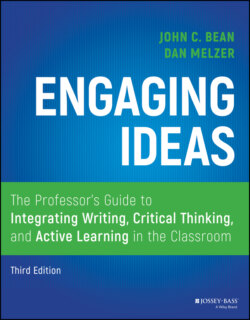Читать книгу Engaging Ideas - John C. Bean - Страница 57
What Causes These Organizational Problems?
ОглавлениеThe “and then” paper, the “all about” paper, and the data dump paper all reveal a retreat, in some manner, from the reasoned analysis and argumentation that we value in academic writing. Why do these problems occur? A number of explanations have been posed. For example, writing theorists influenced by the Swiss psychologist Jean Piaget have hypothesized that the immature organizational patterns just described are symptomatic of concrete operational reasoners, who tend to focus on data, objects, or things as opposed to propositions or forms (Bradford, 1983; Lunsford, 1979). In writing, concrete operational reasoners can string details together chronologically (“and then” writing) or arrange them in simple informational categories (“all about” writing). But creating the kinds of nested hierarchical structures required in propositional writing requires the abstract thinking that characterizes formal operations.
Other explanations focus on theories of intellectual development cited previously in this chapter, such as Perry's (1970) and Belenky, Clinchy, Goldberger, and Tarule's (1986) schemas of cognitive growth. In both schemas, students come to college imagining knowledge as the acquisition of correct information rather than the ability, say, to argue a position or connect to a conversation. Eventually, students develop a complex view of knowledge, where individuals have to take stands in the light of their own values and the best available reasons and evidence and understand and empathize with multiple perspectives on complex issues. Composition scholars using these theories have hypothesized that students will produce cognitively immature prose as long as their attitude toward knowledge remains in the early stages of intellectual growth (Hays, 1983; Lunsford, 1985). The best teaching strategies for accelerating students' growth are tasks that ask students to consider multiple points of view; to confront clashing values; and to imagine, analyze, and evaluate alternative solutions to problems. Many of the assignments used as illustrations throughout this book have these aims.
Still other explanations focus on the different cognitive processes of novices versus experts (Alexander, 2003; Beaufort, 2007; Bransford, Brown, and Cocking, 2000; Flower and Hayes, 1977; Graff, 2004; Kurfiss, 1988; Sommers, 1980; Voss, 1989). Novice/expert theory provides perhaps the most hopeful of all explanations because it implies fairly quick improvements in student writing derived from improved teaching practices. In this view, students simply have not been taught the kind of writing admired in the academy. “And then” structures, “all about” structures, and data dumping are the result of poorly designed writing assignments and uncoordinated teaching.
For example, many teachers report improvement in their students' writing when they explain how expert academic writers construct an introduction (Booth, Colomb, and Williams, 2008): early in the introduction the writer must identify a problem, show why the problem is problematic, and motivate readers to see the problem's importance. Other teachers report the benefits of teaching students what Graff and Birkenstein (2009) call “the moves that matter in academic prose.” Building on Graff's (2004) earlier analysis of students as outsiders to academic prose, Graff and Birkenstein set out to demystify academic prose by showing students how to insert their own voices into academic conversations. (Later in this chapter we summarize some of the “moves” taught by Graff and Birkenstein, 2009.)
